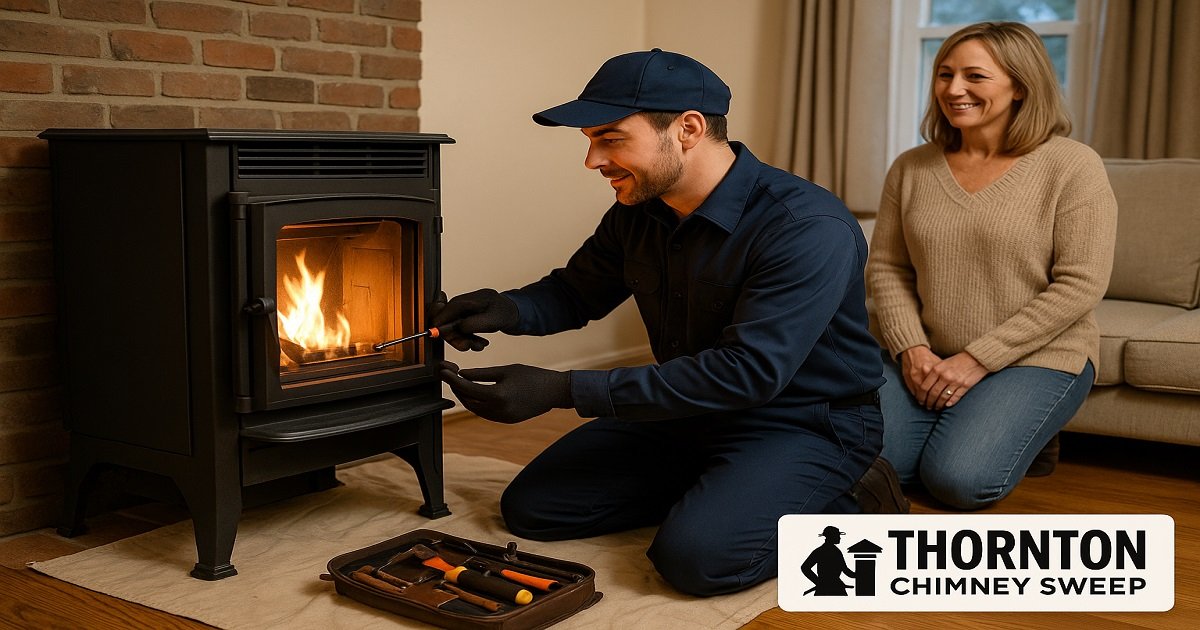
If you live in Thornton or anywhere nearby, you know how much a pellet stove can make winter bearable. There’s nothing quite like that cozy warmth filling your home. But, just like any appliance, your pellet stove needs some love and care to keep running smoothly. Regular check-ups and simple cleaning routines can save you from big headaches (and bills) down the road. If you’re new to pellet stoves repair or just want to keep yours out of the repair shop, let’s chat about some easy ways to keep things humming along.
“A little attention today saves a lot of trouble tomorrow—especially when it comes to keeping your pellet stove happy.”
Key Features: What Makes Your Pellet Stove Tick?
Before diving into the how-to’s, it helps to know what you’re working with. A pellet stove is more than just a box that burns pellets. It has a whole team of parts working together—the hopper, the auger that feeds the pellets, the burn pot, the exhaust fan, and some electronics that make it all run on cue. Each feature plays a role, so understanding them makes maintenance less of a mystery.
| Feature | Why It Matters | Simple Maintenance Tip |
|---|---|---|
| Hopper | Holds the pellets ready to burn | Empty and wipe out dust every few weeks |
| Auger | Feeds pellets into the fire | Check for jams and clear debris monthly |
| Burn Pot | Where the magic (fire) happens | Scoop out ash and unburned pellets regularly |
| Exhaust Fan | Keeps air moving and smoke out | Vacuum dust and check for blockages |
| Electronics | Controls and sensors for safe operation | Keep dry and dust-free, inspect cords for wear |
Taking a few minutes to check on these parts can help you spot small problems before they grow. If you’re ever unsure, your stove’s manual is a great cheat sheet!
Safety First: Cleaning and Inspections
Safety should always be your starting point. Dust, ash, and even pellet crumbs can build up and clog important parts. When air can’t flow or a sensor gets blocked, your stove might shut down or, worse, become a fire risk. So, it pays off to stay on top of cleaning.
- Let the stove cool completely before cleaning.
- Empty the ash pan every few days when in heavy use.
- Vacuum out the burn pot and around the auger weekly.
- Wipe down glass doors to keep an eye on the flame.
- Check vents and the exhaust pipe for buildup monthly.
Make a habit of glancing over wires and seals while cleaning. If you spot something loose or broken, it’s better to fix it now than wait for a chilly night when the stove refuses to start!
Counting Costs: How Maintenance Saves You Money
It’s easy to put off cleaning or wait until the stove acts up. But every bit of routine care is money in your pocket. A neglected pellet stove can burn through pellets faster, work less efficiently, or even break down completely—all things that cost a lot more than a simple cleaning brush.
Here’s how good maintenance helps your wallet:
- Fewer breakdowns means fewer repair bills.
- Clean stoves use less fuel, so you buy fewer pellets.
- Parts last longer, so you’re not replacing them every season.
- A well-kept stove even boosts your home’s value if you ever sell.
Think of maintenance as insurance—it might not be glamorous, but it sure beats a surprise bill when the weather turns cold.
Emergency Service: When to Call in the Pros
Sometimes, even with the best care, things go wrong. If you smell smoke inside (when you shouldn’t), hear strange grinding noises, or your stove just won’t fire up, that’s your cue to call in an expert. Thornton has plenty of skilled technicians who can swoop in when you need help fast.
Here’s when to skip the DIY and reach for the phone:
- Persistent error codes on the control panel
- Unusual smells or visible smoke in the room
- Sparks or electrical issues
- Major pellet jams that won’t clear with gentle cleaning
Don’t wait until a small problem becomes a big one. Emergency service is there for a reason, and catching issues early is always safer.
FAQs: Common Questions About Pellet Stove Maintenance
A: If you use your stove daily in winter, aim for a quick clean once a week, with deeper cleaning and vent checks monthly.
A: Use a vacuum made for ash or fine dust. Regular home vacuums can get damaged or even catch fire with hot ash.
A: Not really! Good quality pellets produce less ash and keep your stove cleaner, so spend a little more for the best results.
A: This could mean a dirty sensor, clogged vent, or electrical issue. Clean first, and if that doesn’t help, call a pro.
Final Thoughts: Keep the Warmth Going
Keeping your pellet stove in top shape doesn’t have to be complicated. A few minutes here and there for cleaning, paying attention to how it sounds and feels, and knowing when to get help can prevent most repairs. In Thornton, where a good stove makes winter so much better, a little maintenance goes a long way. Stay warm, stay safe, and give your pellet stove the care it deserves!
Read More: Thornton Chimney Sweep

